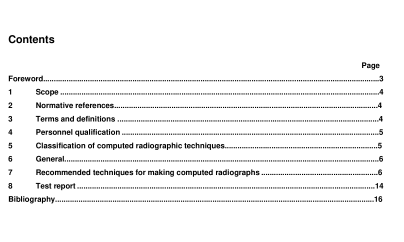BS EN 14784-2:2005 – Non-destructive testing — Industrial computed radiography with storage phosphor imaging plates — Part 2: General principles for testing of metallic materials using X-rays and gamma rays

6 General
6.1 Protection against ionising radiation WARNING — Exposure of any part of the human body to X-rays or gamma-rays can be highly injurious to health. Wherever X-ray equipment or radioactive sources are in use, appropriate legal requirements must be applied. Local or national or international safety precautions when using ionizing radiation shall be strictly applied.
6.2 Surface preparation and stage of manufacture In general, surface preparation is not necessary, but where surface imperfections or coatings might cause difficulty in detecting defects, the surface shall be ground smooth or the coatings shall be removed. Unless otherwise specified computed radiography shall be carried out after the final stage of manufacture, e.g. after grinding or heat treatment.
6.3 Identification of radiographs Symbols shall be affixed to each section of the object being radiographed. The images of these symbols shall appear in the radiograph outside the region of interest where possible and shall ensure unequivocal identification of the section.
6.4 Marking Permanent markings on the object to be examined shall be made in order to locate accurately the position of each radiograph. Where the natures of the material and/or its service conditions do not permit permanent marking, the location may be recorded by means of accurate sketches or photographs.
6.5 Overlap of phosphor imaging plates When radiographing an area with two or more separate phosphor imaging plates (IP), the IPs shall overlap sufficiently to ensure that the complete region of interest is radiographed. This shall be verified by a high-density marker on the surface of the object that will appear on each image.
6.6 Image quality indicators The quality of image shall be verified by use of IQIs, in accordance with the specific application of the following European Standards – EN 462-1 for the contrast resolution and EN 462-5 for measurement of un-sharpness. Therefore, two IQIs are always required on each image. The minimum IQI-values in dependence on wall thickness and geometry are defined by EN 462-3. This document may be applied to non-ferrous metals if appropriate IQIs are used. In specific application cases minimum IQI-values may be specified in accordance with EN 462-4. IQIs of the step-hole type (e.g. EN 462 2) should not be applied because the wire IQIs are more suitable to encourage the operator to compensate for limited sharpness with increased contrast. This compensation can be achieved either by reduction of the source voltage or by longer exposure time to increase the SNR of the computed radiograph.
7 Recommended techniques for making computed radiographs
7.1 Test arrangements Test arrangements shall be determined from the specific application standards for film radiography as e.g. EN 1 435 and EN 1 2681 .
BS EN 14784-2:2005 – Non-destructive testing — Industrial computed radiography with storage phosphor imaging plates — Part 2: General principles for testing of metallic materials using X-rays and gamma rays